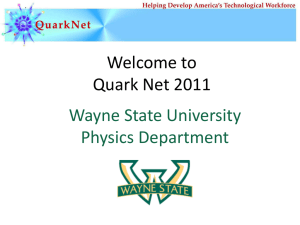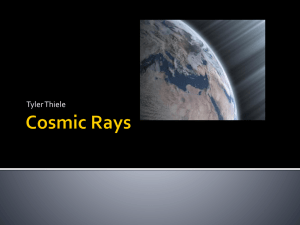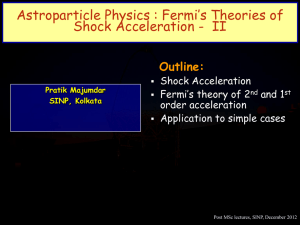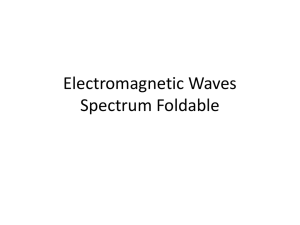Cosmic Ray - Saha Institute of Nuclear Physics
advertisement
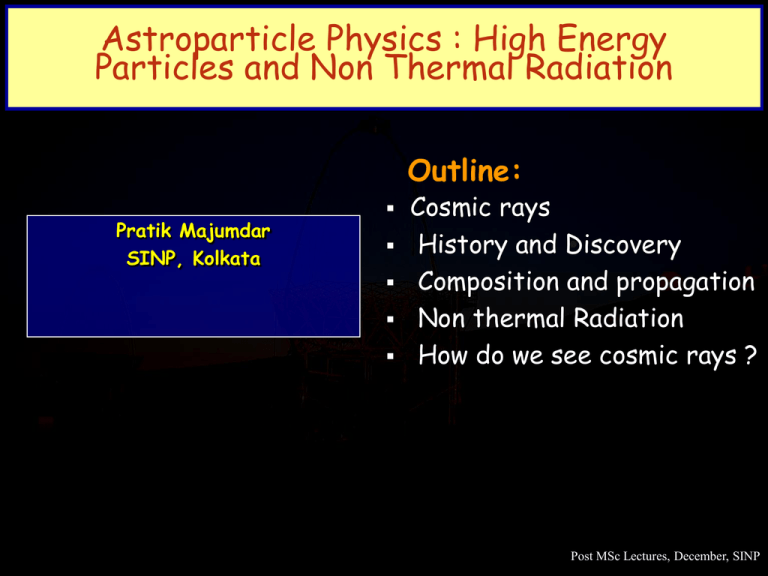
Astroparticle Physics : High Energy Particles and Non Thermal Radiation Outline: Pratik Majumdar SINP, Kolkata Cosmic rays History and Discovery Composition and propagation Non thermal Radiation How do we see cosmic rays ? Post MSc Lectures, December, SINP Reading Materials Longair : High Energy Astrophysics • T. Stanev : High Energy Cosmic Rays • T. Gaisser : Particle Physics and Cosmic rays • Many review articles on the subject • Post MSc Lectures, December, SINP Astroparticle Physics Dark matter Cosmic rays Solar neutrinos Gamma ray astronomy Neutrino masses Gravitational waves Beyond Standard Model Cosmology Neutrino astronomy Post MSc Lectures, December, SINP What are cosmic rays ? • • • • High Energy particles Fully ionised atoms (98%, mainly Hydrogen and He) < 1% Electrons and photons Secondaries : high energy particles generated by interactions of cosmic rays in atmosphere • • • • Achtung : more than 50,000 of such particles are going through you in < 30 mins Particle identification in tracks of emulsion plates Development of Geiger counters, Cloud chamber Birth of Particle Physics in Cosmic rays ( 1920 to 1940 ) Post MSc Lectures, December, SINP History of Cosmic rays Wulf : expt. At Eiffel Tower • At 330 mts ionization decreased to 60% • Millikan named it “cosmic” -> gamma rays • Skobeltsyn recorded the first images in cloud chambers • Bothe and Kolhoerster designed the first coincidence technique to show they are indeed charged particles. (1929) • Post MSc Lectures, December, SINP History of Cosmic Rays: 1912 1912 Victor Hess Investigated sources of radiation – took balloon up to 5000 meters Found radiation increased after 2500 meters This could be attributed to the fact that there was less atmosphere above to shield him from radiation Thus he discovered that radiation is coming from space ... “cosmic radiation” Won Nobel Prize in 1936 Hess after his flight, which he took without breathing apparatus in very cold and thin air! What are cosmic rays (CRs)? As it turns out, these charged particles are atomic nuclei zooming through space Called “primary” CRs Mostly protons or a (He) nuclei (other elements too, in much shorter supply) There are more coming in at lower than higher energies When these hit another nucleus in the atmosphere and stop, more particles are knocked downward, causing a cascading effect called a “shower” Particles in the shower are called “secondary” CRs Cosmic Ray “Showers” Space “Primary” Cosmic Ray (Ion, for example a proton) Earth’s atmosphere Atmospheric Nucleus p- po g g e+ eg Creating: g p+ “Secondary” Cosmic Rays... (about 50 produced after first collision) po g e- Electromagnetic Shower (mainly g-rays) p- p+ nm m+ muon neutrino Hadronic Shower Plus some: (mainly muons and neutrinos Neutrons Carbon-14 reach earth’s surface) Particle Physics Cosmic Rays Electrons and positrons in cloud chambers Tracks in Spark Chambers Post MSc Lectures, December, SINP Discovering Elementary particles Anderson and Neddermeyer discovered muons (1936) Blackett and others went to high altitudes, Pic du Midi obs. Nuclear emulsion plates Post MSc Lectures, December, SINP Cosmic rays (1930-1945) First detection of Air showers Cosmic rays, gamma rays and neutrinos are all linked Post MSc Lectures, December, SINP The Cosmic Ray Spectrum 1 particle per m^2 per sec solar modulation E-2.7, mostly protons 1 particle per m^2 per year Knee transition to heavier nuclei E-3.1 mostly Fe? 1 particle per Km^2 per year transition to LHC lighter nuclei ? Direct Measurements EAS Detectors Ankle ? Power Laws Shock Acceleration predicts FSource E-2 Post MSc Lectures, December, SINP Open questions after 100 years What and where are the sources? How do they work? How are the particles really accelerated?... …or due to new physics at large mass scales? And how do cosmic rays manage to reach us? Post MSc Lectures, December, SINP Cosmic Rays Composition Composition • • • • • mainly protons (chemical composition similar to solar system) Abundances provide information about origin and propagation Nuclei with Z > 1 more abundant in cosmic rays than solar system C,N,O, Fe are similar Overabundance of Li, Be, B in cosmic rays Post MSc Lectures, December, SINP Cosmic Rays Composition • Primaries : Initially produced from H, He in stars • Secondaries : Produced from heavier nuclei ( C, N, O, Fe) • Overabundance of Li, Be, B produced due to Spallation The existence (and the relative importance) of the secondary nucleons is an indication that the cosmic rays have crossed a certain amount of column density of order (of 1 interaction length) X ~ 10 g cm-2 Post MSc Lectures, December, SINP Post MSc Lectures, December, SINP Propagation in the Galaxy Amount of matter traversed decreases as energy increases ; higher energy CRs spend less time • CRs propagate freely in containment volume with a constant probability to escape • Calculate average matter encountered during their lifetime in Galaxy • Taking into account simple Leaky box model Mean amount of matter λesc = τescρβc • Confinement time ~ 106 years Post MSc Lectures, December, SINP Propagation in the Galaxy Contd… • If CRs travelled in straight path : L = t c L ~ 1016 pc >> 15 Kpc (rgalaxy) CRs get deflected many times by the magnetic field Confinement in galaxy is a diffusive process which takes a long time. Post MSc Lectures, December, SINP Diffusion of Cosmic rays How diffusion occur ? Random scatterings by irregularities in magnetic field Fluctuations in the field. • Diffusion loss equation : Exercise : Show this neglecting interactions , where energy loss -dE/dt = b(E) and Q(E,x,t ) is rate of injection of particles Post MSc Lectures, December, SINP Propagation in the Galaxy Contd… • Leaky Box Model Cosmic rays injected Cosmic rays in the Galaxy Escape Time Solve for stationary state Observed Spectrum is different than Source spectrum Post MSc Lectures, December, SINP More on Leaky Box Model • Consider no injection, spallation, energy loss/gain terms : If particles diffuse : exponential, • If particles remain within confinement volume with characteristic escape time, exponential distribution • Post MSc Lectures, December, SINP Number Density of Cosmic Rays Post MSc Lectures, December, SINP Post MSc Lectures, December, SINP Energy Density of Cosmic Rays Number density is then : Calculate energy density : Post MSc Lectures, December, SINP Post MSc Lectures, December, SINP Energetics to CR sources Post MSc Lectures, December, SINP Possible sources Typical flares from ordinary stars like Sun ~ 1034 ergs/sec • Consider all stars : not enough energy !!!! Supernova remnants ? • Explosion rate ~ 1 per 30 yrs in our galaxy Supernova explosion energy ~ 1051 ergs Supernova can supply energy to galactic cosmic rays ??? Post MSc Lectures, December, SINP apparent source direction Origin of cosmic rays ? charged particle g, n nucleus + X -> p + X‘ p0± -> gg p -> m + n m -> e + nn Summer Lectures, DESY, August 26th Berlin Summer Lectures, DESY, August 26th Berlin Multiwavelength Astronomy optical (eV) Classical Astronomy “The passive Universe” Thermal radiation of T=3.000 - 10.000 K optical view of our Galaxy December 5th Kolkata Infrared (10-2eV) Classical Astronomy “The passive Universe” Thermal radiation of T=3.000 - 10.000 K underlying structure fully revealed in infrared image (Spitzer) December 5th Kolkata SN1987A Non-thermal Astronomy “The revolutionary Universe” • Violent, non-equilibrium processes in the Universe => non-thermal radiation • Energy stored in non-thermal radiation similar to energy in thermal radiation or magnetic fields => large contribution to energy balance and evolution of Cosmos December 5th Kolkata Radio (10-6eV) Radio Astronomy: “First window to violent universe” Crab Cyg-A jets in radio galaxies Radio waves emitted by synchrotron radiation of relativistic electrons gyrating in magnetic fields Rotation axis Magnetic axis Pulsed radio emission from pulsars December 5th Kolkata X-ray (103eV) X-ray Astronomy: Direct probe of high energy universe Crab Cyg-A hot intergalactic gas X-ray emission is bremsstrahlung of hot gas (T=107-108K) (Chandra) Non-thermal synchrotron radiation Sources: pulsars X-ray binaries AGNs ….. December 5th Kolkata Very High Energy g-ray Astronomy TeV Gamma-rays (1012eV) • Youngest astronomic discipline • First significant measurement of TeV g-ray emission from Crab Nebula by Whipple telescope in 1989 • Flux Too Low • Numerous background from charged particles December 5th Kolkata Next Lectures : We studied Cosmic rays and its propagation Next lecture : Acceleration of Cosmic rays What type of sources can accelerate cosmic rays ??? December 4th Berlin Backup Slides December 4th Berlin Post MSc Lectures, December, SINP SNR Parameters • Mean ejecta speed : v = (2ESN/Mej)1/2 • Radius swept away : R = (3Mej/4Pr)1/3 • Sweep time : t0 = R/v • ISM density : r = 1.4mpnh Post MSc Lectures, December, SINP Central Question in HE Astrophysics • Is there unambiguous evidence for the acceleration of hadrons in any or all cosmic sources? Victor Hess, 1911 Discovery of the Cosmic Radiation Origin still disputed in 2012 Cosmic Rays • • first & most direct evidence of non-thermal universe plasma of particles with up to 1020eV in our own galaxy ??? Post MSc Lectures, December, SINP 1912 discovered by Victor Hess

